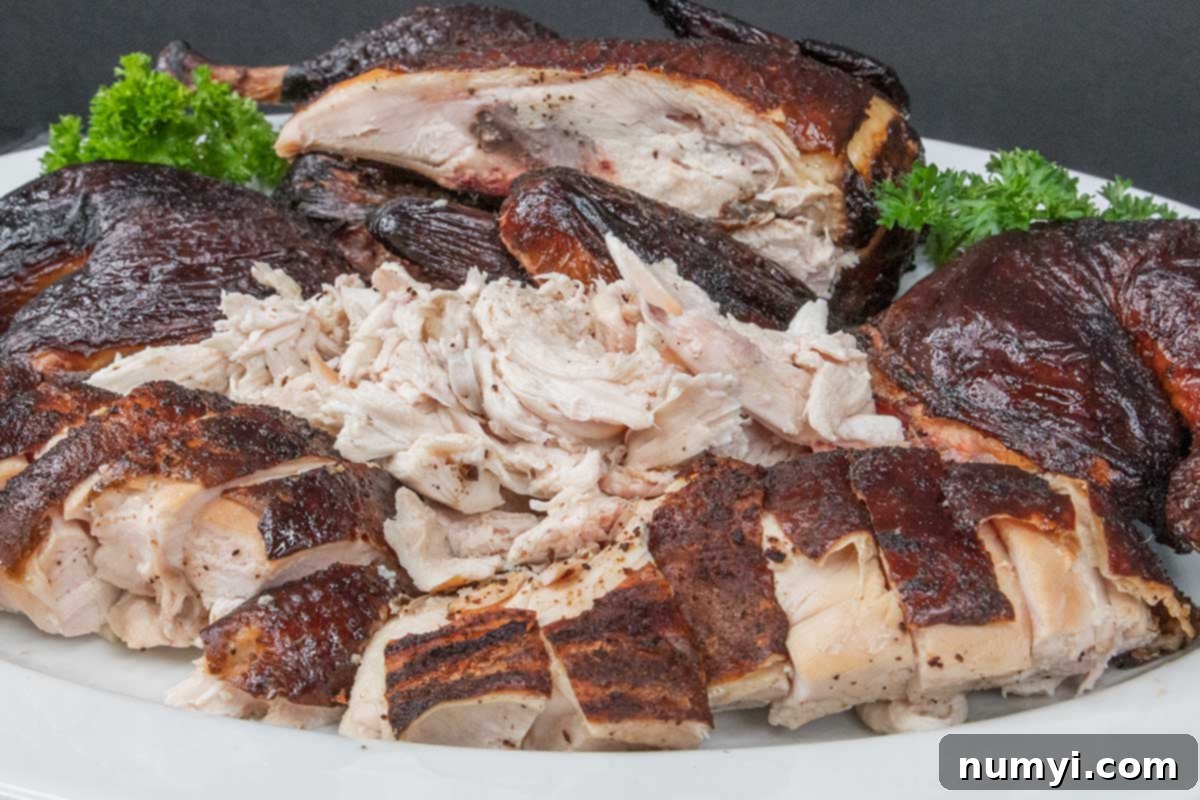The Ultimate Guide to Perfectly Smoked Whole Chicken: Juicy, Tender, and Irresistibly Smoky
Prepare to amaze your taste buds and impress everyone with this comprehensive guide to crafting the most fabulous smoked chicken. We’re talking about a bird that’s incredibly juicy, perfectly tender, and infused with a deep, smoky flavor that will truly blow everybody away. Forget dry, bland chicken – this recipe ensures a succulent, memorable meal every time.
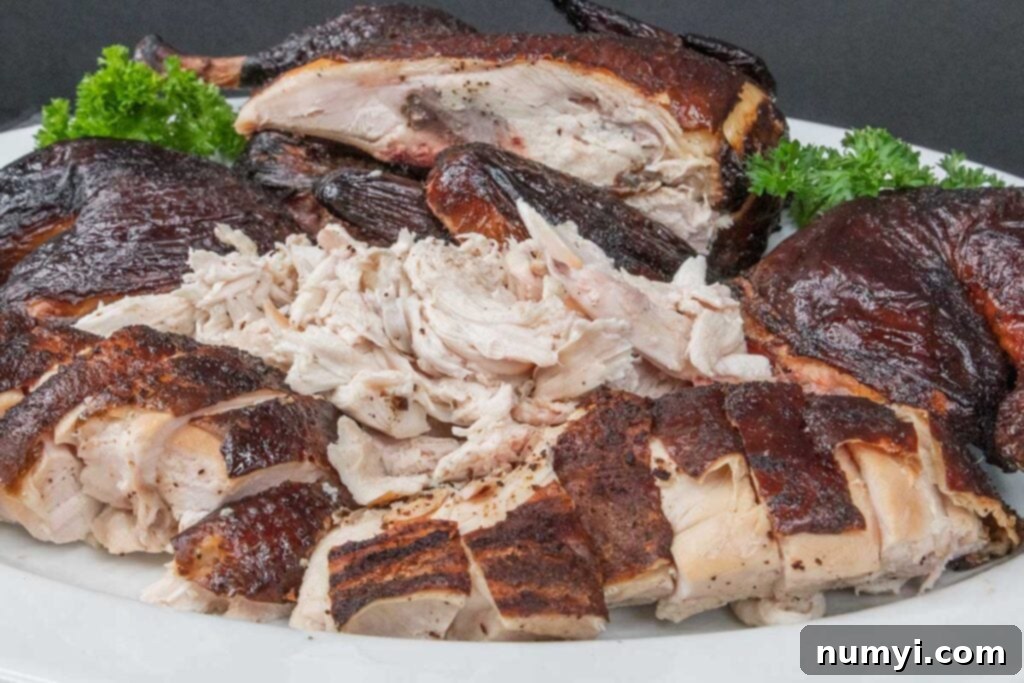
Spatchcock vs. Whole Chicken: Which Method Reigns Supreme for Smoking?
Embarking on the journey to perfect smoked chicken often raises crucial questions, especially regarding preparation methods. One of the most common dilemmas is whether to smoke a chicken whole or spatchcock it. When I initially set out to develop this ultimate smoked chicken recipe, I had these very questions, and I hope this article will provide clear, data-backed answers for you too.
My primary concern revolved around the cook time and smoke penetration. Spatchcocking, also known as butterflying, is renowned for significantly reducing cooking time – often by as much as half compared to a whole chicken. This faster cook is certainly appealing, but I wondered if it would compromise the depth of smoky flavor. I personally prefer an aggressive, pronounced smoke on my chicken; I want to truly *taste* the smoke, not just have it subtly lurking in the background. My goal was to determine if the quicker cook of a spatchcocked bird could still deliver that robust flavor profile.
Another key question involved the seasoning. Should I opt for a minimalist dry brine consisting primarily of salt, enhanced with a touch of onion and garlic powder, or would a more complex, standard BBQ rub be superior? These were the hypotheses I aimed to test. For the sake of empirical evidence – and perhaps to justify smoking four chickens at once to my partner, Leigh – I decided on a controlled experiment: I would spatchcock two chickens and smoke two others whole, each with different seasoning approaches. It was all for science, of course!
Curious to skip straight to the results and discover our findings? Jump directly to our Key Learnings section.
What Is Spatchcock Chicken and How to Prepare It
Spatchcocking a chicken is a simple yet transformative technique where the backbone is removed, allowing the chicken to lay completely flat. This method, essentially the same as “butterflying” the bird, dramatically increases the surface area exposed to heat, leading to faster and more even cooking. It’s a game-changer for many poultry recipes, and we wanted to see its effect on smoked chicken.
In our experiment, two of the chickens were spatchcocked: one received a simple dry brine of salt and aromatics, while the other was seasoned with a popular, sugar-free BBQ rub. Here’s how you can expertly spatchcock a chicken:
- **Prepare the Chicken:** Begin by placing your chicken breast-side down on a clean cutting board, with the backbone facing upwards. Locate the “parson’s nose” – the small, triangular piece of fat at the rear of the bird – and orient it towards you.
- **Remove the Backbone:** Using a sturdy pair of kitchen shears – this is crucial for making clean cuts – carefully cut along one side of the backbone, working your way through the ribs until you reach the end.
- **Repeat on the Other Side:** Turn the chicken slightly and repeat the cutting process along the other side of the backbone. Once both cuts are made, the backbone should be completely detached. You can discard the backbone or save it to make flavorful chicken stock.
- **Trim Excess:** Use paper towels to pat dry any residual moisture on the chicken, which helps with skin crisping later. With your kitchen shears, trim off any large, loose flaps of skin or excessive fat that might just hang and burn without rendering or smoking properly.
- **Flatten the Bird:** Flip the chicken over so the breast side is now facing up. Spread it out wide. With firm, even pressure, press down hard on the breastbone until you hear it crack. This allows the chicken to lay completely flat. If it’s too challenging to crack by pressing, a quick tap with the back of a heavy kitchen knife at the top of the breastbone can help start the process, then follow with firm pressure.
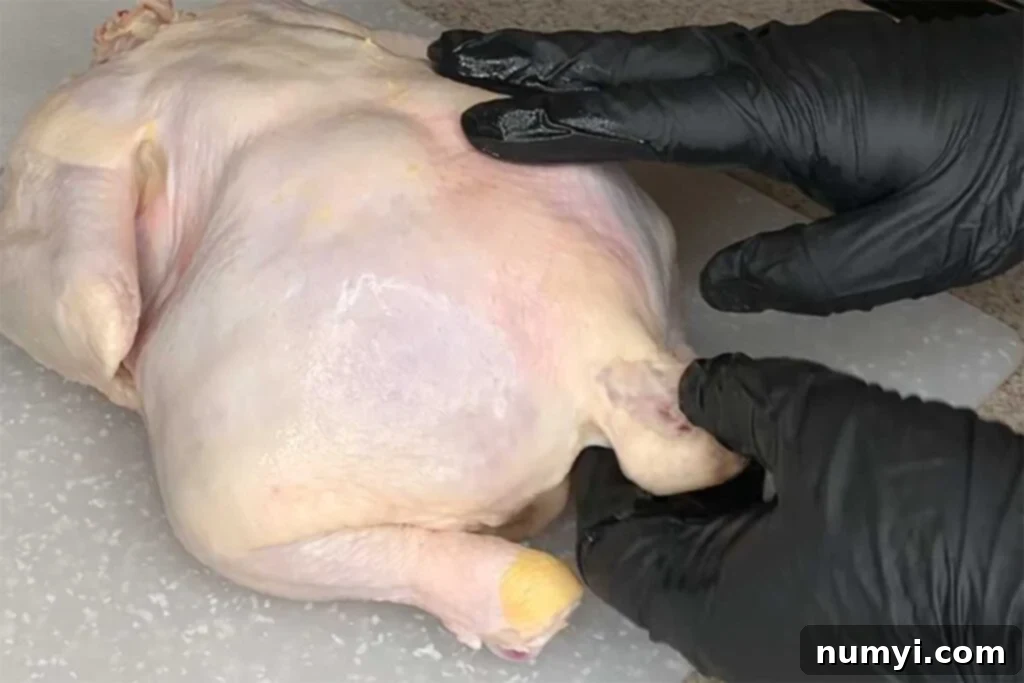
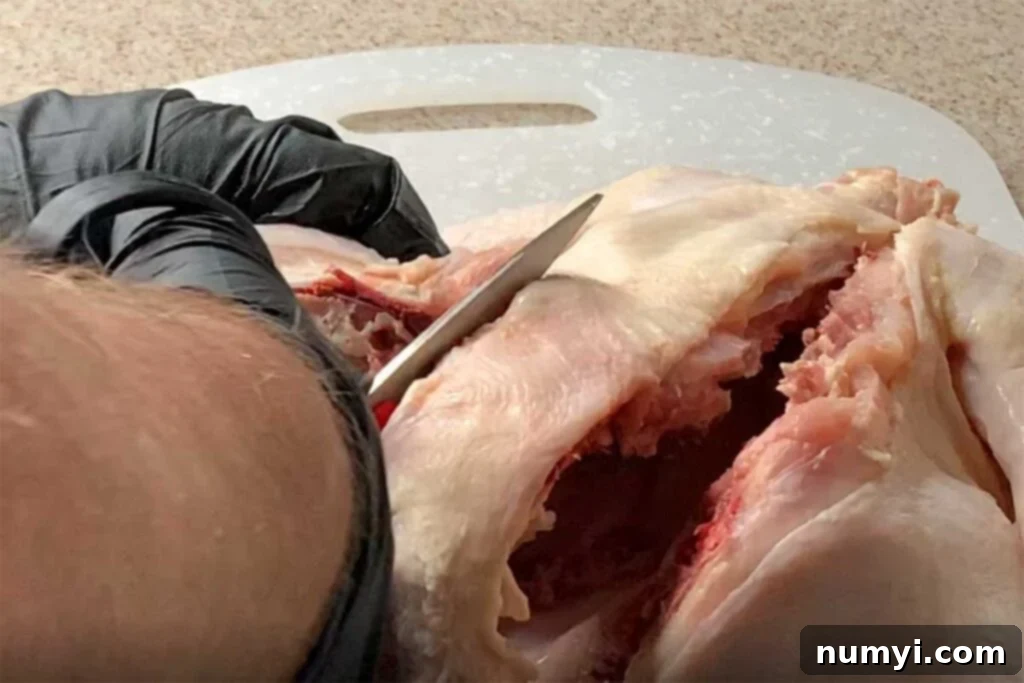
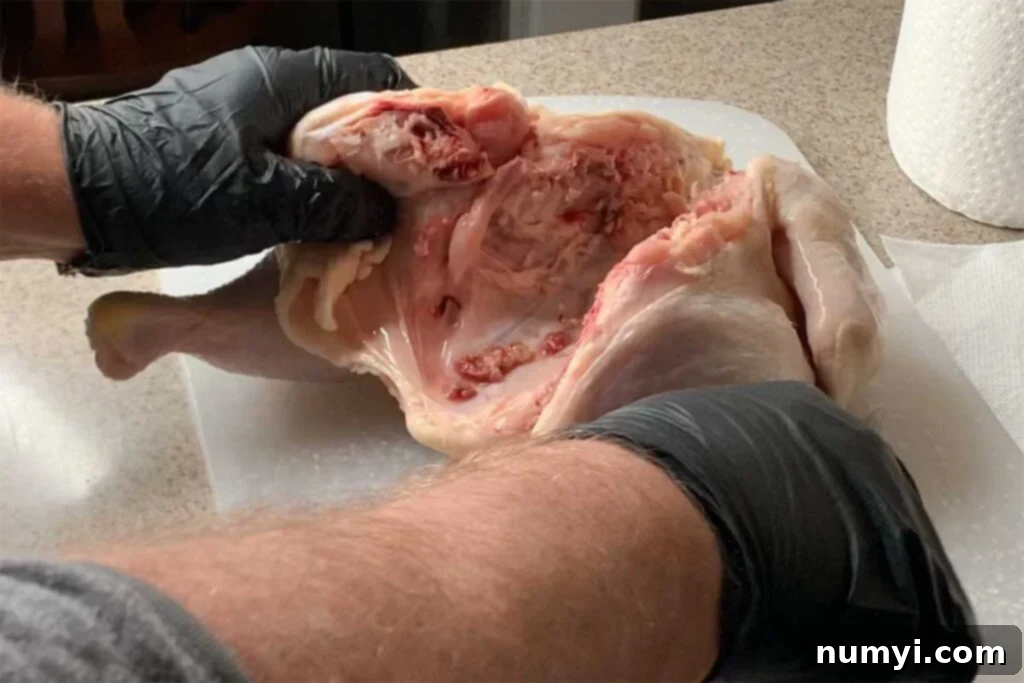
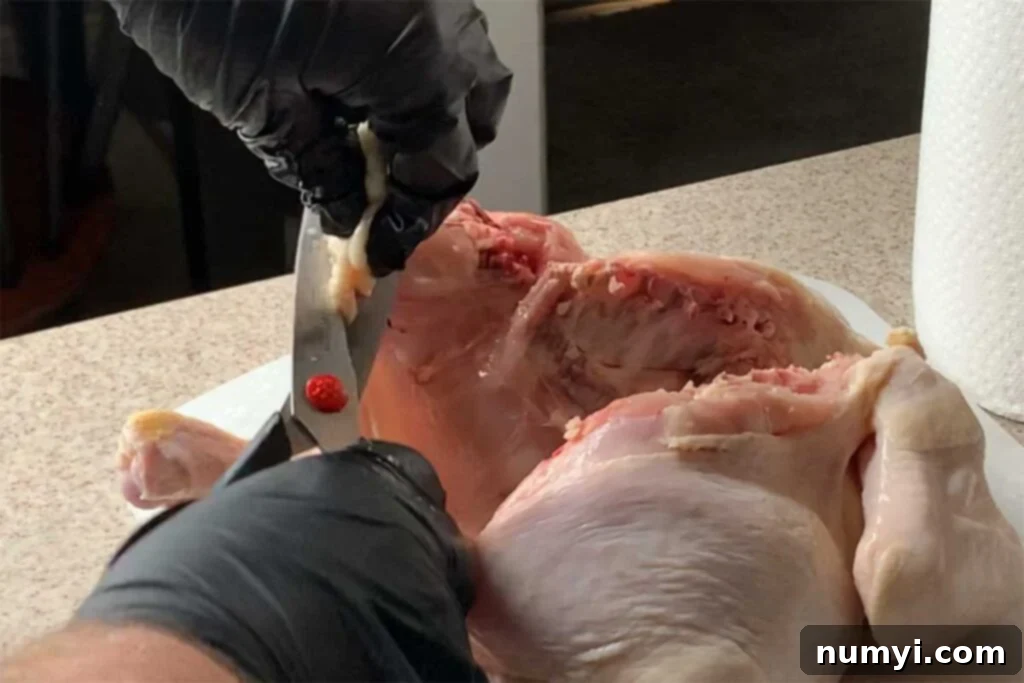
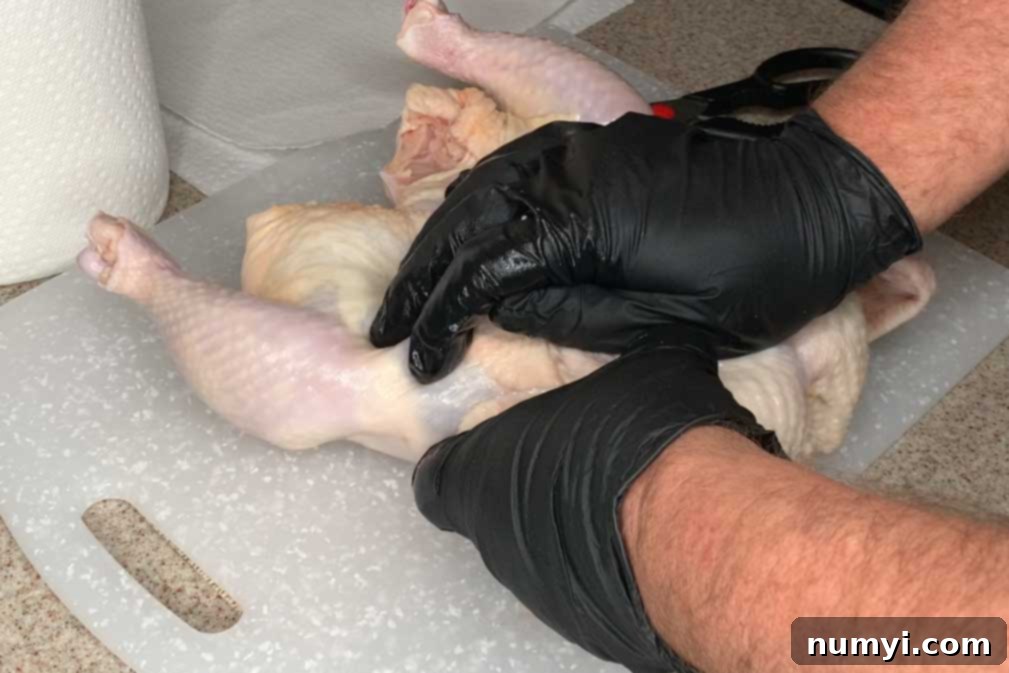
Once the breastbone is cracked, your chicken will lay beautifully flat on the smoker. This preparation method ensures that the entire bird cooks at a more uniform rate and significantly reduces smoking time. For a typical 5-pound chicken, you can expect a cook time of approximately 2.5 to 3 hours at 250-275°F, which we’ll discuss in more detail later.
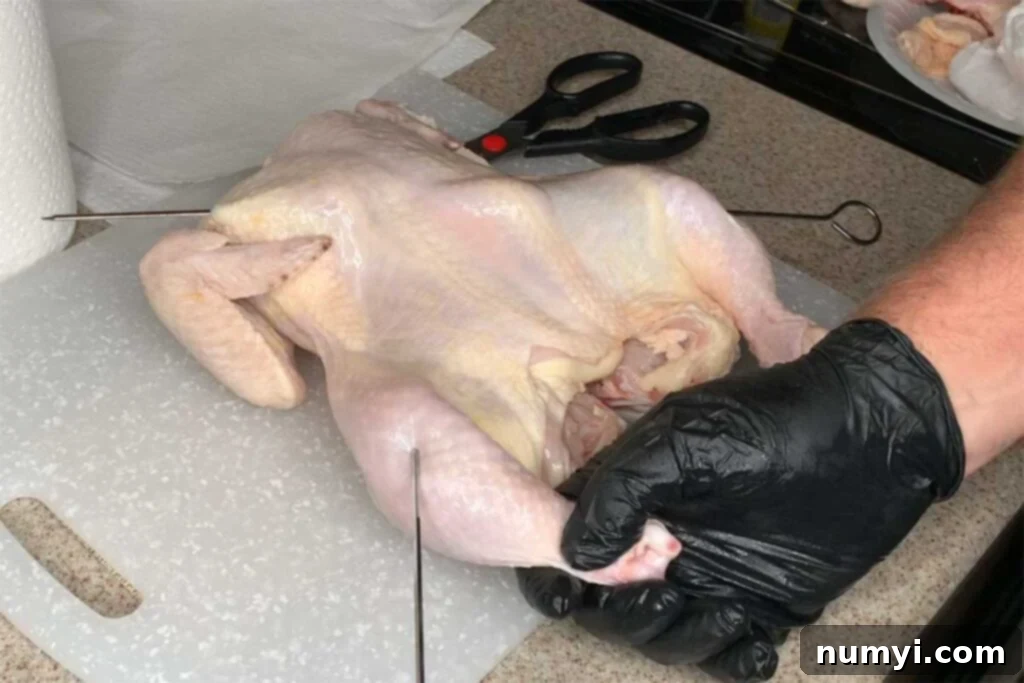
A note on maintaining flatness: some pitmasters recommend skewering the chicken through the leg, across the body, and through the opposite breast. I tested this technique to see if it made a discernible difference in the cooking process or final product. In my experience, it did not significantly impact the cook when smoking at lower temperatures. However, you are welcome to use this method, especially if you plan to smoke at higher temperatures (above 275°F) where maintaining shape might be more critical.
The Art of Seasoning: Mastering the Dry Brine for Flavor and Tenderness
After preparing your chicken, the next critical step is seasoning. This stage is paramount for infusing flavor deep into the meat and ensuring a tender, juicy result. As part of my initial experimentation, I wanted to compare two distinct dry brining approaches:
- A straightforward dry brine focusing on salt and common aromatics.
- A reputable, sugar-free BBQ rub that also provided good salt content.
For the simple, aromatic dry brine, I combined the following ingredients in a small bowl:
- 1 tbsp Kosher Salt (critical for tenderizing)
- 1/2 tsp Garlic powder (adds foundational aromatic flavor)
- 1/2 tsp Onion powder (enhances savory notes)
- 1/2 tsp Freshly ground black pepper (provides a gentle kick and aroma)
On the other test chicken, I used Bad Byron’s Butt Rub. My choice was deliberate: I looked for a rub without added sugars (to prevent burning during long smokes) and with a robust salt presence, which is essential for effective dry brining. The concept of dry brining itself is a culinary revelation we discovered years ago, and we haven’t looked back to traditional wet brines since. Dry brining allows the salt to slowly penetrate the meat through osmosis, not only seasoning it from within but also breaking down muscle fibers. This process results in incredibly juicy, succulent meat with superior texture. A significant advantage of dry brining is that it helps to draw moisture from the skin, leading to a much better chance of achieving a crispy finish, something often impossible with wet brined poultry.
During my side-by-side taste test, I critically compared the chicken seasoned with the simple salt brine to the one with the BBQ rub. What I found was quite insightful: **the choice between a simple salt brine and a good quality, sugar-free BBQ rub made very little difference in the overall flavor of the *smoked* chicken meat itself.** I detected only a faint hint of heat from Bad Byron’s rub that was absent in the salt-only version, but the fundamental smoky chicken flavor dominated both. Given this finding, I opted to season the two whole (non-spatchcocked) chickens with Bad Byron’s, mainly for the subtle warmth it provided without masking the smoke.
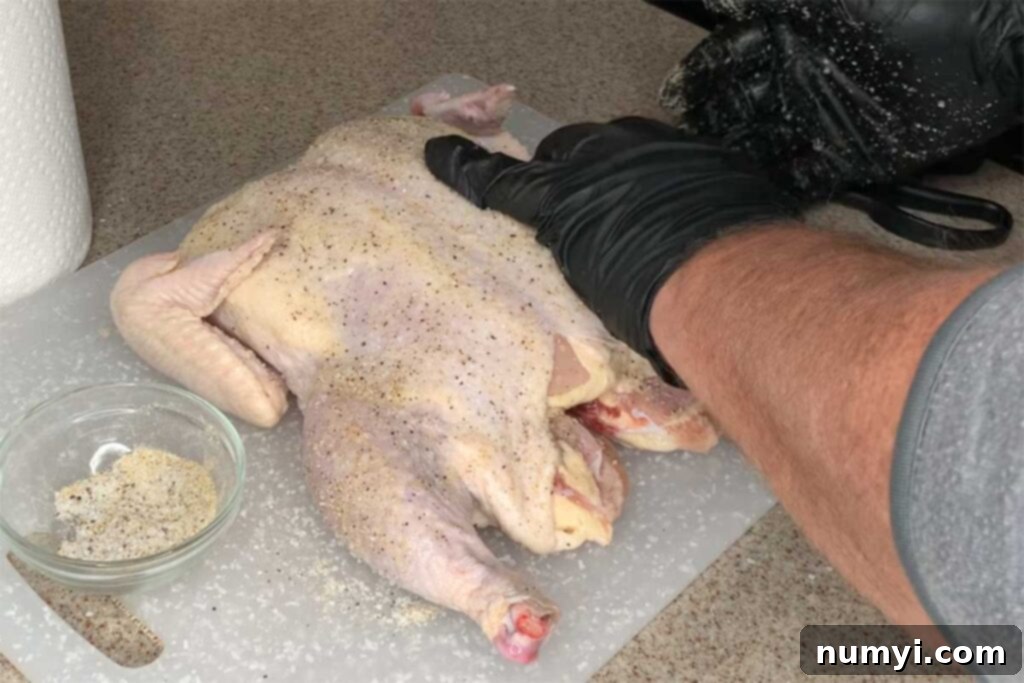
Regardless of your chosen seasoning, apply your rub generously to both sides of the chicken, paying particular attention to the thicker parts like the breasts and thighs to ensure even flavor distribution. Once thoroughly covered, place the chicken on a baking sheet, cover it tightly with plastic wrap, and refrigerate for a minimum of 8 hours. For best results and maximum flavor penetration, we strongly recommend brining it overnight, or for up to 24 hours. The longer the dry brine, the more effectively the salt works its magic, tenderizing and deeply seasoning the meat for an unparalleled juicy and flavorful outcome.
Dressing and Preparing Your Whole Chicken for the Smoker
While spatchcocking simplifies some aspects of cooking, preparing a whole chicken requires a bit of attention to ensure even cooking and a great presentation. This process, often referred to as “dressing” or “trussing” the chicken, helps to compact the bird and prevents certain parts from overcooking before others are done.
The primary benefit of dressing a whole chicken is promoting uniform cooking. By tying the legs together so they are touching, you ensure the thighs and drumsticks cook more evenly with the breast. This prevents the outer parts of the legs from drying out while the inner thigh still needs more time. Additionally, dressing gives the cooked chicken a neater, more appealing appearance, which is always a plus when serving.
Another crucial step for whole chickens is to fold the wing tips underneath the bird before placing it on the smoker. The wing tips are thin and prone to drying out and burning quickly in the smoky environment. Tucking them beneath the body protects them from direct heat and ensures they remain juicy, rather than becoming brittle and charred.
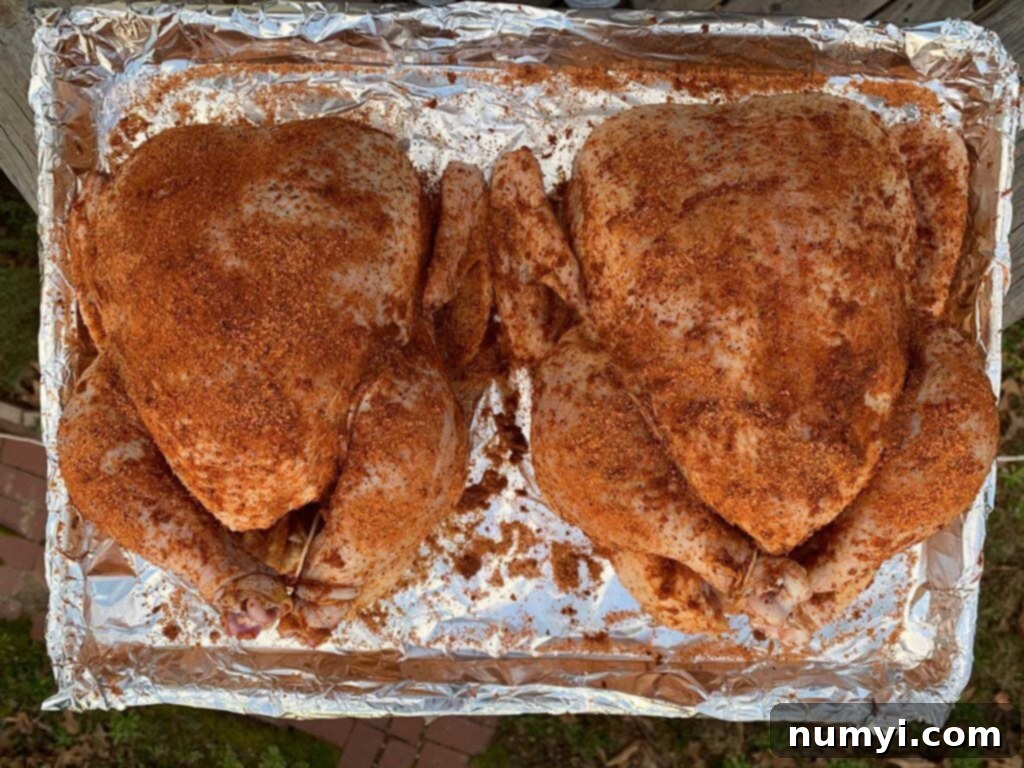
It’s important to note that these dressing techniques are primarily for whole, untrimmed chickens. For spatchcocked chicken, these steps are largely unnecessary as the bird already lays flat, promoting even exposure to heat and smoke across its flattened surface.
Smoking the Whole Chicken: Temperature, Wood, and Time
The magic of smoked chicken truly comes alive in the smoker. Achieving that perfect balance of smoky flavor, tenderness, and juiciness relies heavily on proper temperature control and wood selection. Here’s how to set up your smoker for success and guide your chicken to perfection.
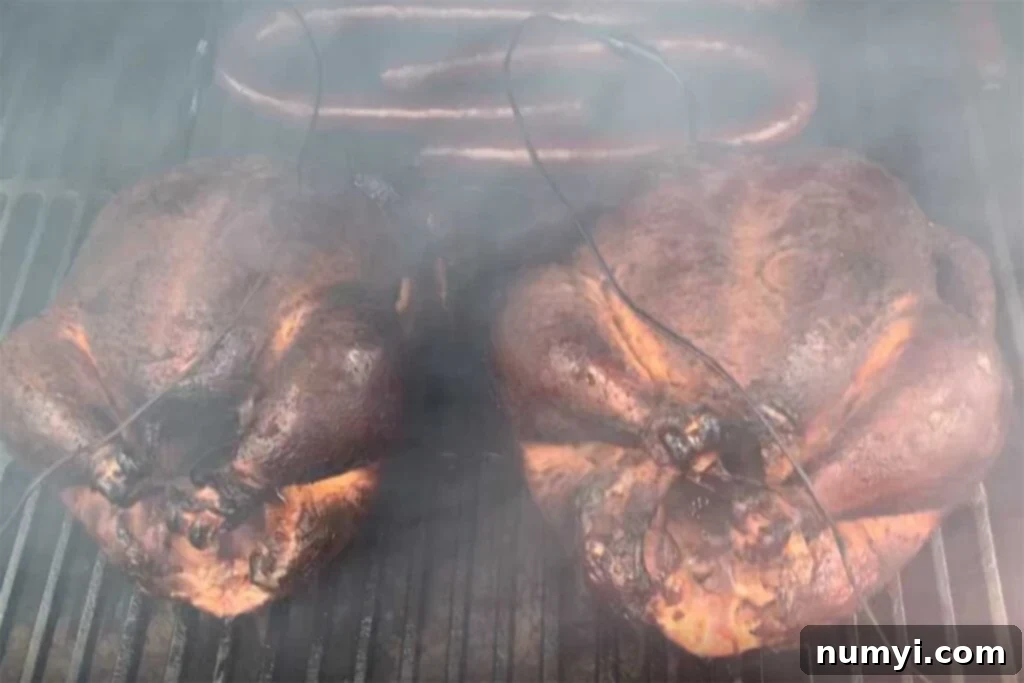
First, preheat your smoker to a stable temperature range of 225-250 degrees Fahrenheit (107-121°C). Maintaining a consistent, low temperature is key for allowing the smoke to penetrate the meat without drying it out or cooking it too quickly. Once your smoker is dialed in, it’s time to add your preferred wood chunks. The choice of wood significantly impacts the final flavor profile. For these chickens, we opted for a combination of oak and hickory. Oak is an excellent choice for a “middle-of-the-road” smoke flavor – it’s strong enough to be noticeable but not overpowering. Hickory, on the other hand, offers a more aggressive and distinct smoky flavor compared to lighter woods like pecan or various fruitwoods (apple, cherry). Other great options include pecan for a milder, nutty smoke, or mesquite for a very bold, robust flavor, if you prefer a more intense smoke profile.
Once your smoker has reached a steady temperature and is producing clean, blue smoke (not thick, white acrid smoke), carefully place your prepared chicken on the grates. Ensure there’s adequate space around each chicken for even smoke circulation. Smoke the chicken until the internal temperature of both the thickest part of the breast and the thigh reaches 165 degrees Fahrenheit (74°C). Always use a reliable meat thermometer inserted into the thickest parts, avoiding bone, to ensure accurate readings.
After reaching the target temperature, remove the chicken from the smoker. This next step is crucial for moisture retention and tenderness: allow the chicken to rest for approximately 20-30 minutes before carving. Resting allows the juices within the meat to redistribute, ensuring every bite is incredibly moist and flavorful. Skipping this step can lead to a drier chicken, as the juices will simply run out upon carving.
Key Differences in Smoked Chicken Cook Time
Our experiment highlighted significant differences in cook times between the spatchcocked and whole chickens, a crucial factor to consider when planning your smoke session.
For the **spatchcock method**, where the chicken lies flat, the increased surface area and uniform thickness allow for a much quicker cook. You can expect a smoke time of about 2.5 to 3 hours for a 5-pound chicken when maintaining a smoker temperature between 225 to 250 degrees F (107-121°C). This makes spatchcocking an ideal choice when you’re looking to get that delicious smoked chicken on the table faster.

In contrast, smoking a **whole chicken** at the same temperature range (225-250 degrees F) will naturally take longer. For a 5-pound whole chicken, anticipate a smoke time of around 5 hours. The denser, more compact shape of a whole bird requires more time for the heat to penetrate fully and cook the meat evenly to the desired internal temperature.
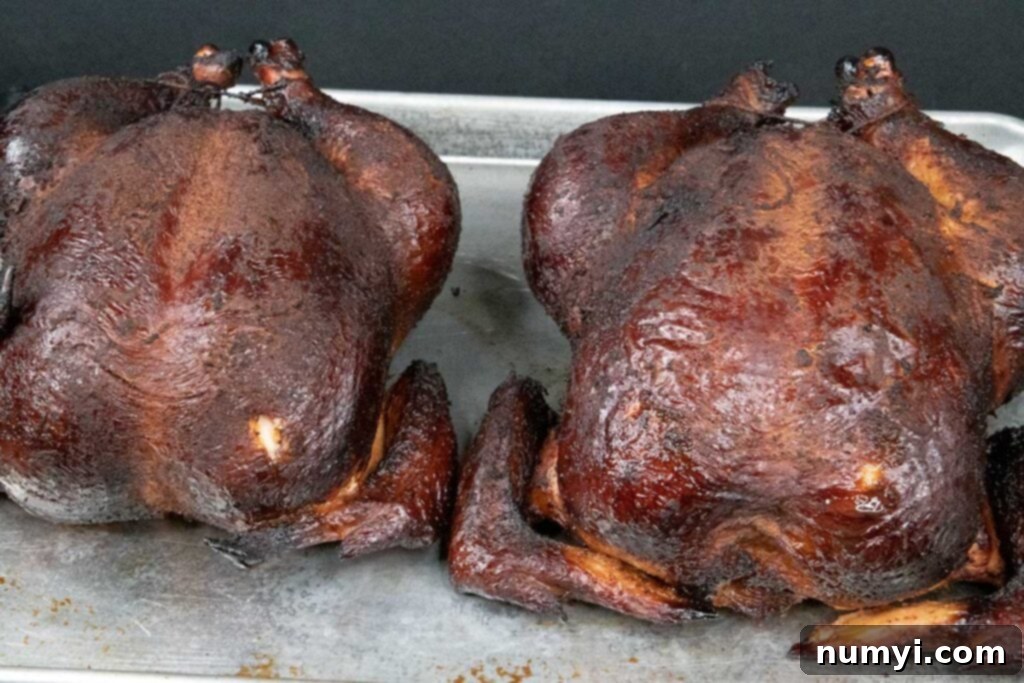
Understanding these time differences is essential for effective meal planning and achieving perfect results, whether you opt for the speedy spatchcock or the traditional whole bird approach.
Key Learnings from Our Smoked Chicken Experiment
Our comprehensive smoking experiment with four chickens – two spatchcocked and two whole – provided invaluable insights into achieving the ultimate smoked chicken. The first smoke session involved the two spatchcocked birds: one seasoned with our simple salt dry brine, and the other with Bad Byron’s Butt Rub (this one was also skewered as a test).
The second session featured the two whole chickens, both seasoned exclusively with Bad Byron’s rub. I chose this rub for the whole birds after finding its subtle hints of heat to be a pleasant addition without overwhelming the natural chicken flavor. This allowed for a clearer comparison of the cooking methods.
Here’s what our empirical evidence revealed:
We discovered that while **spatchcocking the chicken certainly provided a faster route to the dinner table, it did not deliver the aggressive, deep smoke flavor we were truly looking for**. The spatchcocked chicken was undeniably delicious and wonderfully moist throughout, but the smoky essence was noticeably lighter, failing to achieve that rich, robust background note I desired. Furthermore, our seasoning comparison showed that the specific rub, beyond its salt content, did not contribute significantly more to the foundational flavor of the smoked meat, except for that faint touch of heat from the rub. The added step of using skewers to keep the spatchcocked chicken flat also yielded no discernible benefit in terms of cook uniformity or presentation at our tested smoking temperatures.
A crucial observation revolved around the skin. Even when smoking at a slightly higher temperature of 275 degrees Fahrenheit, **we found that the chicken skin remained chewy, not crispy**. This was somewhat anticipated, but I had held out hope for a miracle. Let me be unequivocally clear: anyone who claims that chicken skin is “good” or “crispy” after smoking at 275 degrees is, unfortunately, not being entirely truthful, unless “chewy” is your preferred texture. At lower smoking temperatures, the skin will be even chewier. When aiming for truly smoked chicken, you should plan on discarding the skin if crispiness is your goal.
***It’s vital to understand that BBQ chicken and Smoked Chicken are two fundamentally different things.*** Even at 275 degrees, the skin on a chicken after a low-and-slow smoke will not be crispy. It will be tender and infused with smoke flavor, but it will be soft and pliable. If your objective is crispy skin, you are likely looking for BBQ chicken, which typically involves higher cooking temperatures or a finishing sear. Both styles are excellent, but they offer distinct experiences. You can certainly crank up the heat for crispier skin, but be aware that this will inevitably sacrifice significant smoke time and impact the overall smoky flavor penetration.
Based on our extensive testing, the optimal path to a truly delicious, incredibly juicy, and deeply smoky whole chicken is a straightforward, yet patient, process: **dry brine your chicken overnight to ensure maximum flavor and tenderness, then smoke it at a consistent low temperature of 225 to 250 degrees Fahrenheit**. Continue smoking until the internal temperature in both the breast and thigh registers a perfect 165 degrees Fahrenheit. Once removed from the smoker, allow the chicken to rest for a generous 20 to 30 minutes before expertly carving and serving. This method consistently delivers the aggressive smoke flavor and tender, moist meat that will impress any BBQ enthusiast.
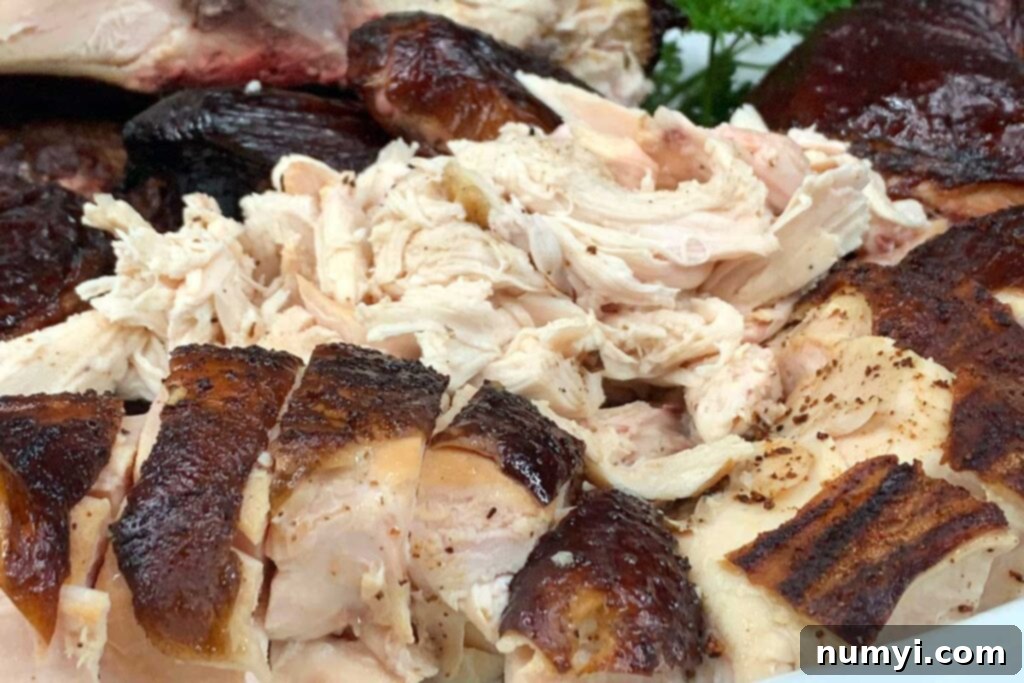
Serve this magnificent smoked chicken however you see fit, though we highly recommend pairing it with some classic Alabama White BBQ Sauce on the side. It’s a culinary match made in heaven! The rich, succulent smoky chicken with the tangy, peppery bite of the white sauce creates an exquisite flavor combination. We even serve our equally delicious smoked chicken wings with the very same sauce.
And while you’re firing up the smoker, why not cook more than just one chicken? Having extra smoked chicken on hand opens up a world of culinary possibilities. We’ve used leftovers to create some truly banging smoked chicken salad, which was absolutely amazing piled high on soft Brioche bread. We also crafted a killer smoked chicken panini sandwich on freshly made sourdough – man, that was one incredibly satisfying sandwich. To be honest, as we were prepping all those birds, I knew the smoked chicken salad was definitely on the menu. The idea for the panini, well, that one came to me in a delightful dream! Happy smoking!
Discover More Grilling and Smoking Recipes!
- Best Ever Grilled Chicken Marinade
- The Best Keto Grilled Pork Tenderloin Recipe
- Smoked Pork Shoulder Recipe
- Fall Off The Bone St Louis Style Ribs
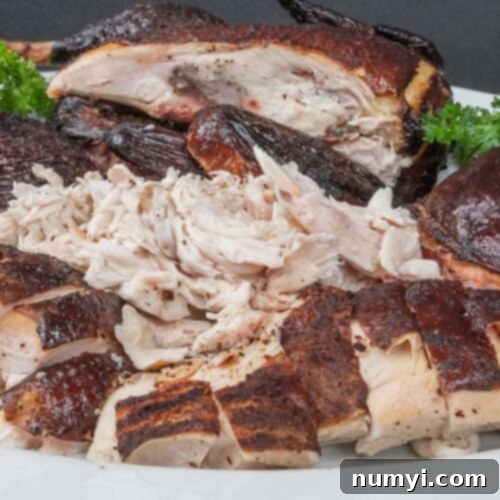
Smoked Whole Chicken Recipe
Print
Pin
Rate
Equipment
-
Smoker
-
Hickory, Oak, Pecan, or a blend of smoking wood chunks.
-
Reliable Meat Thermometer
Ingredients
Dry Brine (or your preferred BBQ rub)
- 1 tbsp Kosher Salt
- 1/2 tsp Onion Powder
- 1/2 tsp Garlic Powder
- 1/2 tsp Pepper freshly ground
Chicken
- Whole Chicken 4-5 lb
Instructions
Prep and Dry Brine
-
In a small bowl, combine all dry brine spices thoroughly. Alternatively, prepare your chosen BBQ rub.
-
Generously apply the rub to the entire surface of the chicken, ensuring good coverage, especially on the breasts and thighs.
-
Place the seasoned chicken on a plate or baking dish, cover tightly with plastic wrap, and refrigerate.
-
Allow the chicken to dry brine for at least 8 hours, and for best results, refrigerate overnight or up to 24 hours.
The Smoke
-
Preheat your smoker to a stable temperature between 225 to 250 degrees Fahrenheit (107-121°C). Add your chosen wood chunks (Hickory, Oak, Pecan, or a blend) for desired smoke flavor.
-
Before placing the chicken in the smoker, dress it: tie the legs together for even cooking and tuck the wing tips under the bird to prevent them from drying out.
-
Place the dressed whole chicken into the preheated smoker.
-
Smoke at 225 to 250 degrees Fahrenheit for approximately 5 hours, or until the thickest part of the breasts and thighs have reached an internal temperature of 165 degrees Fahrenheit (74°C) using a reliable meat thermometer.
-
Remove the smoked chicken from the smoker and allow it to rest, loosely tented with foil, for 20 to 30 minutes. This is crucial for retaining juices.
-
Carve the chicken and serve immediately. Enjoy your perfectly juicy, tender, and smoky chicken!
